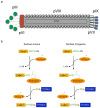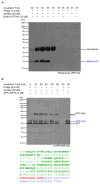M13 bacteriophage display framework that allows sortase-mediated modification of surface-accessible phage proteins
- PMID: 22759232
- PMCID: PMC3564602
- DOI: 10.1021/bc300130z
M13 bacteriophage display framework that allows sortase-mediated modification of surface-accessible phage proteins
Abstract
We exploit bacterial sortases to attach a variety of moieties to the capsid proteins of M13 bacteriophage. We show that pIII, pIX, and pVIII can be functionalized with entities ranging from small molecules (e.g., fluorophores, biotin) to correctly folded proteins (e.g., GFP, antibodies, streptavidin) in a site-specific manner, and with yields that surpass those of any reported using phage display technology. A case in point is modification of pVIII. While a phage vector limits the size of the insert into pVIII to a few amino acids, a phagemid system limits the number of copies actually displayed at the surface of M13. Using sortase-based reactions, a 100-fold increase in the efficiency of display of GFP onto pVIII is achieved. Taking advantage of orthogonal sortases, we can simultaneously target two distinct capsid proteins in the same phage particle and maintain excellent specificity of labeling. As demonstrated in this work, this is a simple and effective method for creating a variety of structures, thus expanding the use of M13 for materials science applications and as a biological tool.
Figures






Similar articles
-
Orthogonal labeling of M13 minor capsid proteins with DNA to self-assemble end-to-end multiphage structures.ACS Synth Biol. 2013 Sep 20;2(9):490-6. doi: 10.1021/sb400019s. Epub 2013 May 28. ACS Synth Biol. 2013. PMID: 23713956 Free PMC article.
-
Efficient affinity-tagging of M13 phage capsid protein IX for immobilization of protein III-displayed oligopeptide probes on abiotic platforms.Appl Microbiol Biotechnol. 2020 Feb;104(3):1201-1209. doi: 10.1007/s00253-019-10338-8. Epub 2020 Jan 4. Appl Microbiol Biotechnol. 2020. PMID: 31900564
-
Expanding the versatility of phage display I: efficient display of peptide-tags on protein VII of the filamentous phage.PLoS One. 2011 Feb 24;6(2):e14702. doi: 10.1371/journal.pone.0014702. PLoS One. 2011. PMID: 21390217 Free PMC article.
-
Engineering M13 for phage display.Biomol Eng. 2001 Sep;18(2):57-63. doi: 10.1016/s1389-0344(01)00087-9. Biomol Eng. 2001. PMID: 11535417 Review.
-
Oligopeptide m13 phage display in pathogen research.Viruses. 2013 Oct 16;5(10):2531-45. doi: 10.3390/v5102531. Viruses. 2013. PMID: 24136040 Free PMC article. Review.
Cited by
-
Bioengineered Polyhydroxyalkanoates as Immobilized Enzyme Scaffolds for Industrial Applications.Front Bioeng Biotechnol. 2020 Mar 4;8:156. doi: 10.3389/fbioe.2020.00156. eCollection 2020. Front Bioeng Biotechnol. 2020. PMID: 32195237 Free PMC article. Review.
-
Expanding the chemical diversity of M13 bacteriophage.Front Microbiol. 2022 Aug 8;13:961093. doi: 10.3389/fmicb.2022.961093. eCollection 2022. Front Microbiol. 2022. PMID: 36003937 Free PMC article. Review.
-
Quantification of Peptide-Bound Particles: A Phage Mimicking Approach via Site-Selective Immobilization on Glass.ACS Omega. 2021 Dec 20;7(1):187-197. doi: 10.1021/acsomega.1c04343. eCollection 2022 Jan 11. ACS Omega. 2021. PMID: 35036690 Free PMC article.
-
Phage display--a powerful technique for immunotherapy: 1. Introduction and potential of therapeutic applications.Hum Vaccin Immunother. 2012 Dec 1;8(12):1817-28. doi: 10.4161/hv.21703. Epub 2012 Aug 21. Hum Vaccin Immunother. 2012. PMID: 22906939 Free PMC article. Review.
-
N-Terminal labeling of filamentous phage to create cancer marker imaging agents.ACS Nano. 2012 Aug 28;6(8):6675-80. doi: 10.1021/nn301134z. Epub 2012 Aug 6. ACS Nano. 2012. PMID: 22830952 Free PMC article.
References
-
- Sidhu SS. Engineering M13 for phage display. Biomol Eng. 2001;18:57–63. - PubMed
-
- Burritt JB, Quinn MT, Jutila MA, Bond CW, Jesaitis AJ. Topological mapping of neutrophil cytochrome b epitopes with phage-display libraries. J Biol Chem. 1995;270:16974–80. - PubMed
-
- Barry MA, Dower WJ, Johnston SA. Toward cell-targeting gene therapy vectors: selection of cell-binding peptides from random peptide-presenting phage libraries. Nat Med. 1996;2:299–305. - PubMed
Publication types
MeSH terms
Substances
Grants and funding
LinkOut - more resources
Full Text Sources
Other Literature Sources
Research Materials

